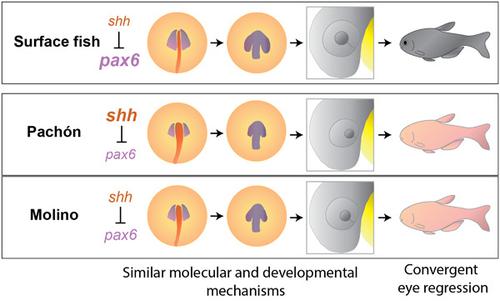当前位置:
X-MOL 学术
›
J. Exp. Zool. B Mol. Dev. Evol.
›
论文详情
Our official English website, www.x-mol.net, welcomes your
feedback! (Note: you will need to create a separate account there.)
Repeated evolution of eye loss in Mexican cavefish: Evidence of similar developmental mechanisms in independently evolved populations.
Journal of Experimental Zoology-B: Molecular and Developmental Evolution ( IF 1.8 ) Pub Date : 2020-07-02 , DOI: 10.1002/jez.b.22977 Itzel Sifuentes-Romero 1 , Estephany Ferrufino 1 , Sunishka Thakur 1 , Lauren A Laboissonniere 2 , Michael Solomon 1 , Courtney L Smith 2 , Alex C Keene 3 , Jeffrey M Trimarchi 2 , Johanna E Kowalko 1
Journal of Experimental Zoology-B: Molecular and Developmental Evolution ( IF 1.8 ) Pub Date : 2020-07-02 , DOI: 10.1002/jez.b.22977 Itzel Sifuentes-Romero 1 , Estephany Ferrufino 1 , Sunishka Thakur 1 , Lauren A Laboissonniere 2 , Michael Solomon 1 , Courtney L Smith 2 , Alex C Keene 3 , Jeffrey M Trimarchi 2 , Johanna E Kowalko 1
Affiliation

|
Evolution in similar environments often leads to convergence of behavioral and anatomical traits. A classic example of convergent trait evolution is the reduced traits that characterize many cave animals: reduction or loss of pigmentation and eyes. While these traits have evolved many times, relatively little is known about whether these traits repeatedly evolve through the same or different molecular and developmental mechanisms. The small freshwater fish, Astyanax mexicanus, provides an opportunity to investigate the repeated evolution of cave traits. A. mexicanus exists as two forms, a sighted, surface‐dwelling form and at least 29 populations of a blind, cave‐dwelling form that initially develops eyes that subsequently degenerate. We compared eye morphology and the expression of eye regulatory genes in developing surface fish and two independently evolved cavefish populations, Pachón and Molino. We found that many of the previously described molecular and morphological alterations that occur during eye development in Pachón cavefish are also found in Molino cavefish. However, for many of these traits, the Molino cavefish have a less severe phenotype than Pachón cavefish. Further, cave–cave hybrid fish have larger eyes and lenses during early development compared with fish from either parental population, suggesting that some different changes underlie eye loss in these two populations. Together, these data support the hypothesis that these two cavefish populations evolved eye loss independently, yet through some of the same developmental and molecular mechanisms.
中文翻译:

墨西哥洞穴鱼眼球反复进化:独立进化种群中类似发育机制的证据。
在相似环境中的进化通常会导致行为和解剖特征的融合。收敛性状进化的一个典型例子是许多洞穴动物的特征性状减少:色素沉着或眼睛减少或消失。尽管这些性状已经进化了许多次,但对于这些性状是否通过相同或不同的分子和发育机制反复进化却知之甚少。小型淡水鱼类Astyanax mexicanus为研究洞穴性状的反复演变提供了机会。墨西哥曲霉它以两种形式存在,即有视力的地面居住形式和至少29个盲人的洞穴居住形式,最初会发展成眼睛,然后退化。我们比较了发育中的表面鱼类和两个独立进化的洞穴鱼类种群Pachón和Molino的眼睛形态和眼睛调节基因的表达。我们发现在Molino洞穴鱼中也发现了许多先前描述的在Pachón洞穴鱼眼发育过程中发生的分子和形态变化。然而,对于许多这些特征,Molino穴鱼的表型不如Pachón穴鱼严重。此外,与任何一个亲代种群的鱼类相比,洞穴-洞穴混合鱼类在早期发育过程中具有更大的眼睛和晶状体,这表明这两个种群的失明是一些不同的变化。一起,
更新日期:2020-07-02
中文翻译:

墨西哥洞穴鱼眼球反复进化:独立进化种群中类似发育机制的证据。
在相似环境中的进化通常会导致行为和解剖特征的融合。收敛性状进化的一个典型例子是许多洞穴动物的特征性状减少:色素沉着或眼睛减少或消失。尽管这些性状已经进化了许多次,但对于这些性状是否通过相同或不同的分子和发育机制反复进化却知之甚少。小型淡水鱼类Astyanax mexicanus为研究洞穴性状的反复演变提供了机会。墨西哥曲霉它以两种形式存在,即有视力的地面居住形式和至少29个盲人的洞穴居住形式,最初会发展成眼睛,然后退化。我们比较了发育中的表面鱼类和两个独立进化的洞穴鱼类种群Pachón和Molino的眼睛形态和眼睛调节基因的表达。我们发现在Molino洞穴鱼中也发现了许多先前描述的在Pachón洞穴鱼眼发育过程中发生的分子和形态变化。然而,对于许多这些特征,Molino穴鱼的表型不如Pachón穴鱼严重。此外,与任何一个亲代种群的鱼类相比,洞穴-洞穴混合鱼类在早期发育过程中具有更大的眼睛和晶状体,这表明这两个种群的失明是一些不同的变化。一起,











































 京公网安备 11010802027423号
京公网安备 11010802027423号